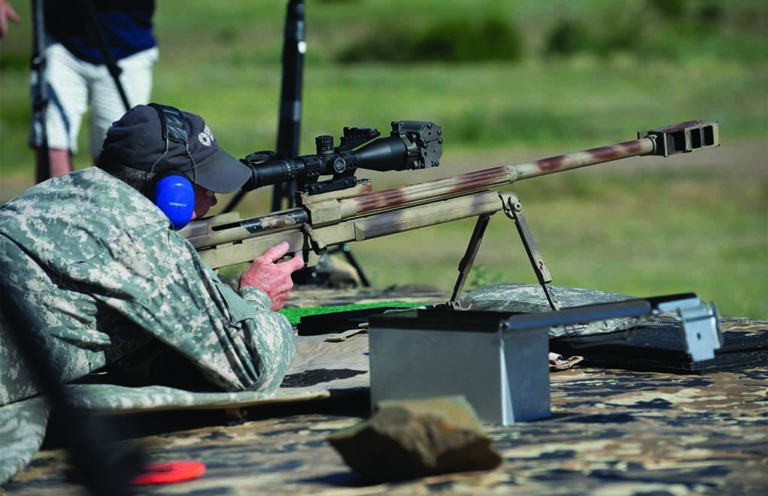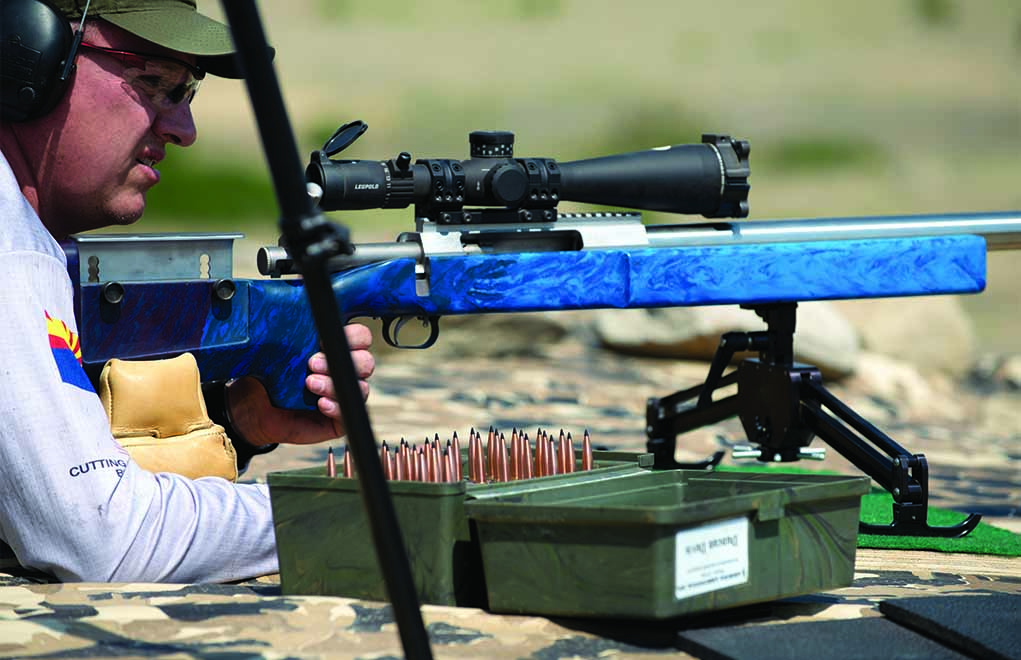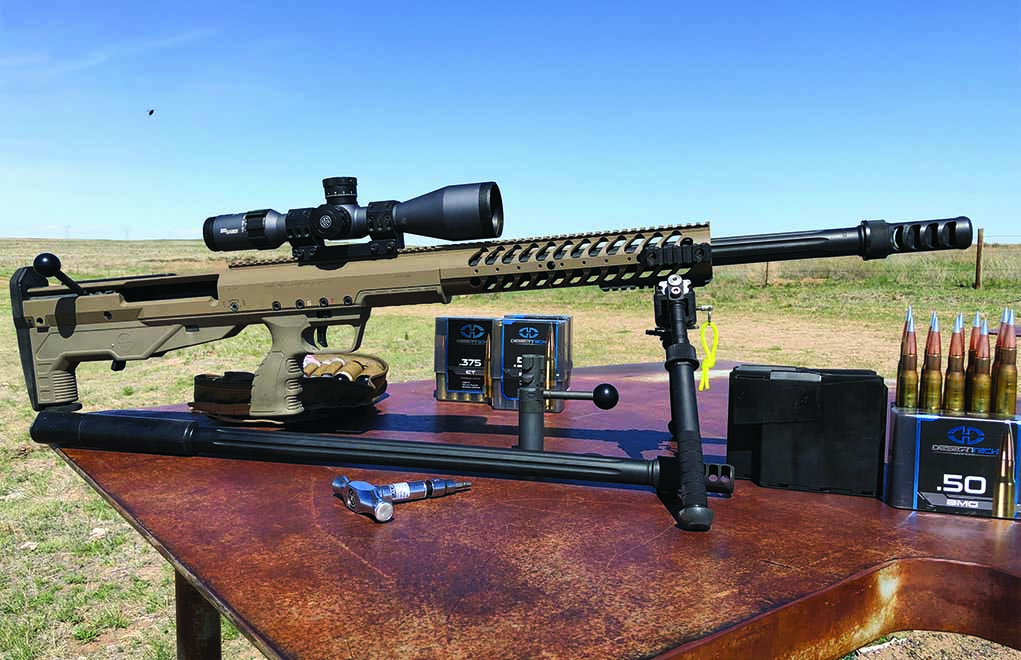
Aiming to shoot 2 miles or further? You need to break out a .50-caliber or other big guns.
Extreme long-range shooting is becoming a popular spectator sport with a host of King of 2 Mile (KO2M) competitions popping up. In the ELR community, the standard is moving to impact a target three consecutive times from a cold bore shot. In other words, you can’t walk into the target; you have to impact it purposefully.
These competitions often start at ranges of about 1,500 yards and then progress out to distances, as the name implies, to two miles. Now, not everyone gets to make the two-mile attempts: This is an elimination race. If you don’t score early and make it into the top 10, you won’t get to attempt the two-mile shots.
I’ve been to several of the King of 2 Mile competitions as a reporter and spoke with many of the competitors about the choices in calibers and equipment they use. This competition grew out of the .50 Caliber competition that’s hosted at the Whittington Center. So, early on, you saw a lot more .50-caliber rifles. Today, the trend has moved to other sporty calibers such as the .375 CheyTac or the .416 from Barrett.
Marine Corps .50-Caliber
Back in the mid-1980s, I was in one of the first Marine Corps units to field the .50-caliber sniper, or SASR. It was a beast of a rifle that was designed by Daisy (yes, the air gun manufacturer), and our rifles were built by Iver Johnson. I remember that name, because my dad had an Iver Johnson .30-caliber carbine from World War II. This .50-caliber rifle felt as if it were going back to that era.

The Marine Corps .50-caliber was big, heavy and had a very short bolt that could be removed from the receiver. Then, you placed a cartridge under the claws of the bolt face to hold it and replaced the entire bolt with an attached cartridge into the rifle to fire. Within the first week, we broke half the scopes on those guns.
Large magnums are not a casual shooter’s rifle. They require a lot of time and energy to master. That said, today, we see shooters doing more with less by reducing the caliber a bit and improving the bullet being shot.
Desert Tech HTI Rifle
I recently worked with a Desert Tech (DT) multi-caliber HTI rifle. “HTI” stands for “hard target interdiction” and is the term used by the military for these big magnums. The DT HTI allowed me to alternate between .50-caliber and .375 CT. In my opinion, the DT platform shines in the HTI calibers. It’s a bullpup-style rifle, so you want the ability to reduce the size of the overall package while keeping all the same barrel lengths.
The Desert Tech rifle allowed me to shoot both calibers on the same day at the same targets. It’s easy to see and harder to put into words the joy of stepping a few dress sizes when launching large projectiles at distant targets. However, I’ll do my best to paint the picture.
‘Smaller’ Calibers
The .50-cal. is an excellent caliber and has been long-serving. However, the punishment inflicted on the shooter is real. The military has guidelines that limit the number of shots it wants a soldier to fire from a .50-caliber rifle. I believe the Air Force limited the number of shots to something like only 10 rounds per day. It was an incredibly small number.

Because of the price point, people will often jump into a .50-caliber rifle before mastering the smaller ones. Ammunition availability is there; you can find surplus rounds almost anywhere. On top of that, the Hornady 750-grain A-Max is a terrific match round for guys who want to push the distance beyond one mile.
Get On Target With Frank Galli:
- Mils vs. MOA: Which Is The Best Long-Range Language?
- Buying the Perfect Precision Scope
- Shooting Positions: Variety Is The Spice Of Life
- Riflescope Tracking: Why It’s Crucial To Test It
- Long-Range Shooting: Becoming Your Own Spotter
My point is that you can do it more effectively—and, most importantly—more accurately with a smaller caliber. The .375 CT is an outstanding caliber to push the limits of ELR shooting for a lot less recoil. That matters when you’re trying to squeeze every bit of accuracy out of the system. The time of flight in these shots is very long, so the way to manage it is to speed up the bullet. And the best way to do that is by dropping a little bullet weight.
Turned, solid bullets are the name of the game, so that also means you’re going to spend more money. Solids are the best way to carry the weight and keep the speed up. During a few of the early KO2M competitions, the shooters noticed their bullets were impacting on the cliff face around the targets. But solids don’t shatter like jacketed bullets and, if they went into the crags, you couldn’t see impact. The solution was to jump up to the .416 Barrett.
The incremental gains on the cartridge were enough to manage the recoil and still jump in weight to see the splash at 2,000 yards. You still have to participate in the event: As a result, managing the shooter is every bit as important as managing the rifle system.

Does that mean the .50-caliber isn’t competitive? Heck, no! It has all the potential in the world … that is, if the shooter is smart about it. In the case of the .50-caliber, you want to finesse your load: Drop the weight, increase the speed, and get a really effective brake.
Lastly, be aware that many ranges will limit .50-caliber use. You can still shoot your .375 CT beyond the five-second time-of-flight range, given the space. The range personnel won’t say anything when you use it and, compared to the granddaddy of them all, you’ll be treated like a prince.
It’s a great sport. And, because the pace is slower, ELR shooting can be very relaxing.
However, don’t forget to double up your ear protection and put yourself straight behind the rifle to manage recoil. If this is a direction you want to go in, be sure to do your homework, because it’s not cheap: The best loads for this type of competition hover around $9 a shot.
Editor's Note: This article originally appeared in the May 2020 issue of Gun Digest the Magazine.

Next Step: Get your FREE Printable Target Pack
Enhance your shooting precision with our 62 MOA Targets, perfect for rifles and handguns. Crafted in collaboration with Storm Tactical for accuracy and versatility.
Subscribe to the Gun Digest email newsletter and get your downloadable target pack sent straight to your inbox. Stay updated with the latest firearms info in the industry.

![Best Concealed Carry Guns In 2025 [Field Tested] Wilson Combat EDC X9S 1](https://gundigest.com/wp-content/uploads/Wilson-Combat-EDC-X9S-1-324x160.jpg)


![Best 9mm Carbine: Affordable PCCs [Tested] Ruger Carbine Shooting](https://gundigest.com/wp-content/uploads/Ruger-Carbine-Shooting-100x70.jpg)
![Best AR-15: Top Options Available Today [Field Tested] Harrington and Richardson PSA XM177E2 feature](https://gundigest.com/wp-content/uploads/Harrington-and-Richardson-PSA-XM177E2-feature-100x70.jpg)
